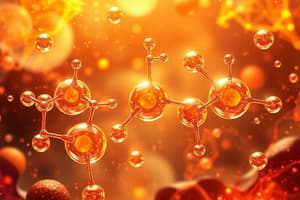Podcast
Questions and Answers
What is the structure characteristic of an aldehyde?
What is the structure characteristic of an aldehyde?
- R2C(=O)
- R2C(=O) with an alkene
- RCH(=O) (correct)
- RCH(=O) with two methyl groups
Which test is used to identify aldehydes by forming a silver mirror?
Which test is used to identify aldehydes by forming a silver mirror?
- 2,4-Dinitrophenyl hydrazine test
- Tollen’s test (correct)
- Fehling's test
- Sodium bisulfite test
What occurs in the 2,4-dinitrophenyl hydrazine test for aldehydes and ketones?
What occurs in the 2,4-dinitrophenyl hydrazine test for aldehydes and ketones?
- Colorless solution
- Formation of a blue precipitate
- Yellow to orange precipitate formation (correct)
- Gas release
Which statement correctly distinguishes between aldehydes and ketones?
Which statement correctly distinguishes between aldehydes and ketones?
What is a common consequence of the sodium bisulfite test for carbonyl compounds?
What is a common consequence of the sodium bisulfite test for carbonyl compounds?
What distinguishes formaldehyde from other aldehydes?
What distinguishes formaldehyde from other aldehydes?
Which reaction is typically used to identify ketones specifically?
Which reaction is typically used to identify ketones specifically?
Aldehydes and ketones are classified based on which functional group?
Aldehydes and ketones are classified based on which functional group?
What is the primary reaction observed when acetaldehyde is subjected to Tollen's test?
What is the primary reaction observed when acetaldehyde is subjected to Tollen's test?
What are the components of Fehling's solution?
What are the components of Fehling's solution?
In the Fehling's test, why do aromatic aldehydes typically not show a reaction?
In the Fehling's test, why do aromatic aldehydes typically not show a reaction?
During the Fehling’s test, what is the color change observed when aldehydes react?
During the Fehling’s test, what is the color change observed when aldehydes react?
What happens to the cupric ions in the Fehling's solution when an aldehyde is present?
What happens to the cupric ions in the Fehling's solution when an aldehyde is present?
What is the significance of ammonium hydroxide in the Tollen's test procedure?
What is the significance of ammonium hydroxide in the Tollen's test procedure?
What precipitate indicates a positive result in Fehling's test when an aldehyde is present?
What precipitate indicates a positive result in Fehling's test when an aldehyde is present?
How many drops of Fehling's solution are used in each test tube during the test procedure?
How many drops of Fehling's solution are used in each test tube during the test procedure?
Flashcards
Aldehyde vs. Ketone
Aldehyde vs. Ketone
Aldehydes have a carbonyl group (C=O) bonded to at least one hydrogen atom, while ketones have a carbonyl group bonded to two carbon atoms.
2,4-Dinitrophenylhydrazine Test
2,4-Dinitrophenylhydrazine Test
This test identifies carbonyl groups (in aldehydes and ketones) by producing a yellow-to-orange precipitate.
Sodium Bisulfite Test
Sodium Bisulfite Test
This test identifies carbonyl groups (in aldehydes and ketones) by forming water-soluble crystals.
Tollen's Test
Tollen's Test
Signup and view all the flashcards
Aldehyde Oxidation
Aldehyde Oxidation
Signup and view all the flashcards
Ketone Oxidation
Ketone Oxidation
Signup and view all the flashcards
Tollen's Reagent
Tollen's Reagent
Signup and view all the flashcards
Carbonyl Group
Carbonyl Group
Signup and view all the flashcards
Fehling's Test
Fehling's Test
Signup and view all the flashcards
Fehling's Reagent
Fehling's Reagent
Signup and view all the flashcards
Aldehyde
Aldehyde
Signup and view all the flashcards
Ketone
Ketone
Signup and view all the flashcards
Reducing Agent
Reducing Agent
Signup and view all the flashcards
Copper(I) oxide
Copper(I) oxide
Signup and view all the flashcards
Aromatic Aldehydes
Aromatic Aldehydes
Signup and view all the flashcards
Study Notes
Aldehydes and Ketones
- Aldehydes and ketones are important organic compounds containing a carbonyl group.
- An aldehyde has the structure RCH(=O), while a ketone has the structure R₂C(=O), where R can be alkyl, alkenyl, alkynyl, or aryl groups.
Aim
- Identify the presence of aldehyde or ketone functional groups in a given organic compound.
- Differentiate between aldehydes and ketones.
Theory
- Low molecular weight aldehydes and ketones are volatile compounds.
- Identification is based on addition and oxidation reactions.
Identifying Aldehydes and Ketones
- 2,4-Dinitrophenylhydrazine test: Aldehydes and ketones react with 2,4-dinitrophenylhydrazine, forming a yellow to orange precipitate.
- Sodium bisulfite test: Aldehydes and ketones combine with sodium bisulfite to create water-soluble "aldehyde bisulfite" and "ketone bisulfite" products. Crystallization confirms a carbonyl group.
Differences between Aldehydes and Ketones
- Aldehydes can easily be oxidized to carboxylic acids, while ketones do not oxidize easily.
- This difference in reactivity is used to distinguish them.
Distinguishing Tests (Examples)
-
Tollen's test (Silver Mirror Test): Freshly prepared Tollen's reagent (silver ammonia complex) is used. Aldehydes react with it, forming a grey-black precipitate or a silver mirror. The aldehyde is oxidized to an acid, and the silver ion is reduced to its elemental form. Ketones generally do not react.
-
Fehling's test: Fehling's solution (a complex compound of Cu²⁺) is used; aldehydes react with it. During the reaction, a red precipitate is formed. A brick red precipitate indicates aldehyde presence. Aromatic aldehydes do not respond to this test.
Fehling's Solution
- Prepared by combining two separate solutions:
- Fehling's (1): Copper(II) sulfate solution
- Fehling's (2): Sodium-potassium tartrate (Rochelle salt) solution
Procedure for Tests (Examples):
-
Tollen's Test Procedure: The procedure for the Tollen's test involves adding silver nitrate, sodium hydroxide, then ammonia to a test tube, followed by the addition of the substance to be tested. Formation of a silver mirror indicates the presence of an aldehyde.
-
Fehling's Test Procedure: Mix equal parts of Fehling's solutions (1 and 2) in a test tube. Add the substance to be tested and heat it. A brick-red precipitate shows an aldehyde's presence.
Studying That Suits You
Use AI to generate personalized quizzes and flashcards to suit your learning preferences.




